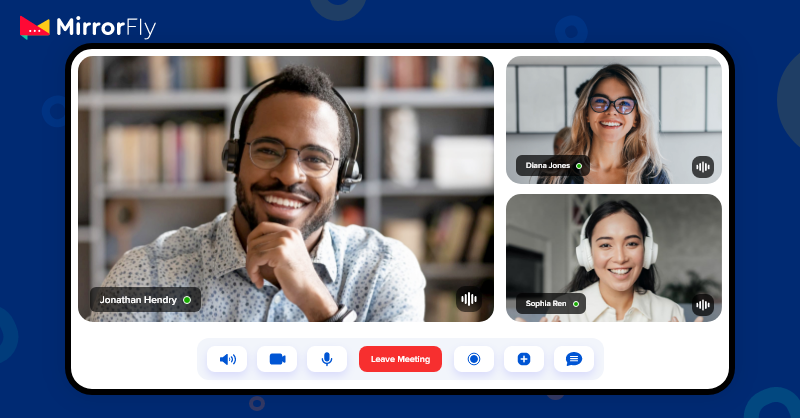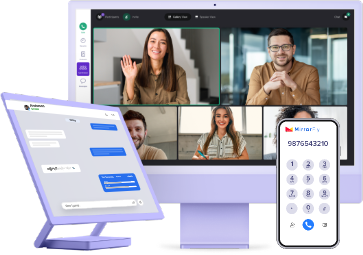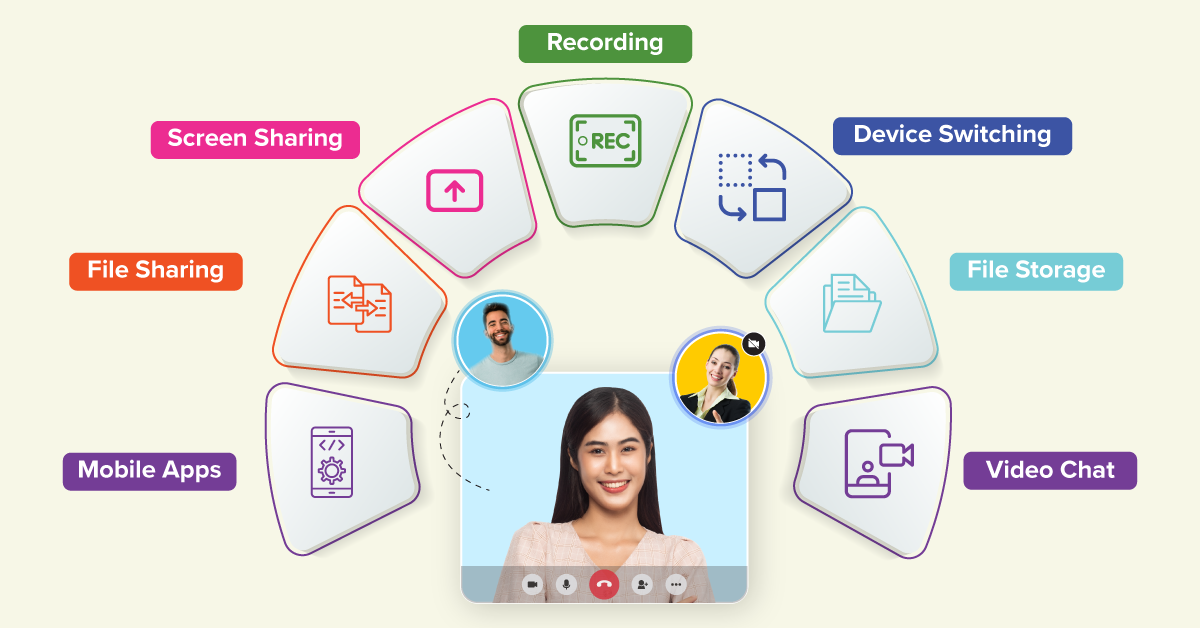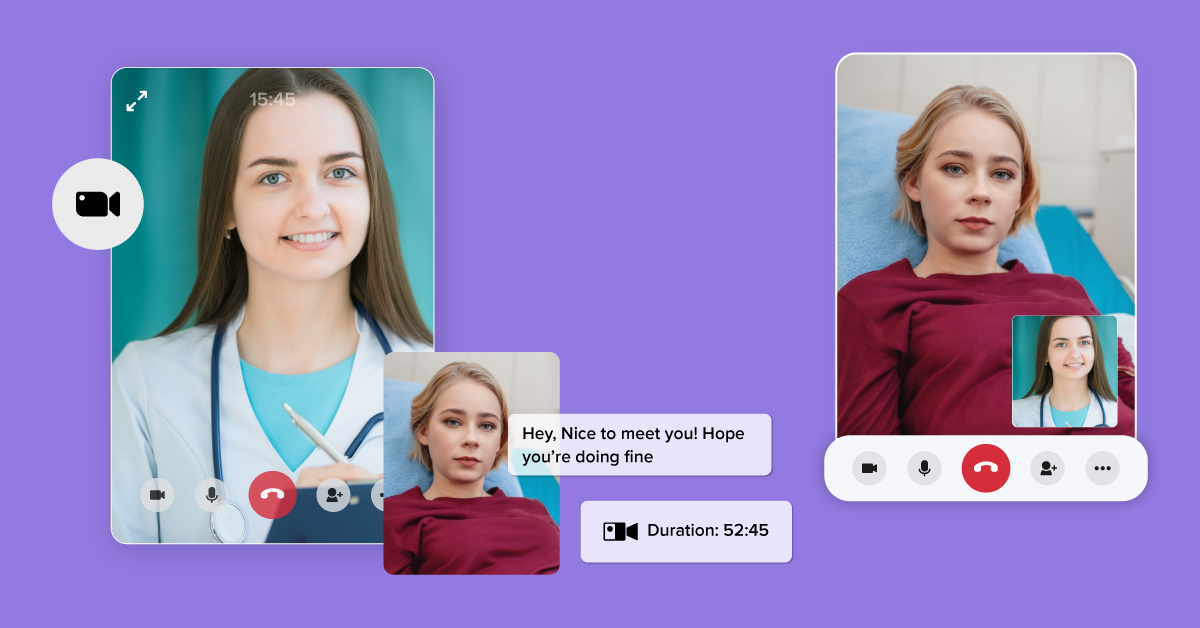Video Communication in 2026: Types, Must Have Features & What’s Next

Post-COVID-19 pandemic, when the year 2021 approached, many of us had already invested in at-home desks and gym equipment, just the way corporations had spent a fortune building video chat apps to make working from home a bit more comfortable and easier.
It might sound astonishing, but what you read above is true because video communication has become the source of every virtual meeting, online consultation, e-learning, and even marketplace. This surge in video calling apps nearly doubled in 2020, thus paving the way for many new advancements in this field.
So, before delving deep into the different video communication platforms, have a look at recent video call trends and video conferencing trends in the market, or any other fortified topics related to it, this blog can be of real help to you.
Table of Contents
What is Video Communication?
Video Communication is simply a type of communication that allows users to connect virtually and discuss business meetings or internal communications face-to-face.
See, the video communication definition does not have any bells and whistles that make it difficult for individuals to understand, right?
Using videos for internal communications is loved both by businesses and individuals, with some even incorporating talking head videos to enhance on-camera presentation. First, it is because video calling apps act as a productivity booster, and secondly, they are adored for bringing people closer. Adding to these, secure video chat apps can also help in
- One-to-One calls
- Team meetings
- Customer support
- Webinars and training
- Recruitment
- WebRTC-enabled secure streaming
- Conducting workshops and more

Video Call API Into Any Web & Mobile App?
- Complete Source Code
- Lifetime Data Ownership
- Deploy on Own Server
Knowledge Fact:
People, let me tell you that video calling isn’t new to the world, as its existence was first felt in the year 1960 during closed-circuit experiments.
Let us hover to the next topic,
Different Types Of Video Communication
When we hear the types of video communication, the first thing that pops out of the box is synchronous and asynchronous video communication. The former type takes place in real-time, and the latter is used for future playbacks, meaning videos are initially recorded and then shared with users.
4 Types of Video Communication
- Video Calling
- Video Conferencing
- Telepresence
- Video Sharing
And the video communication that is booming in this era is the synchronous type, which is classified into:
1. What is Video Calling ?
A video call is a method of phone call that uses an internet connection or VoIP to transmit a live picture of a person in real-time. It helps two or more people connect face-to-face, either on a smartphone, tablet, web app, or webcam. The quality and smoothness of a video call greatly depend on the internet speed, as a faster connection ensures clearer video and better audio without interruptions.
There are multiple Android and iOS apps for video calls on the market that provide a faster and safer way to connect with people face-to-face at any time and any place.
2. What is Video Conferencing?
Video conferencing is an act of video communication that involves two or more people sharing a live connection from various places. Some video conferencing apps support up to 200 participants in a single call. Here, every user can view multiple participants on their screen in the grid view, and this type of communication is widely used across e-learning and enterprise sectors.
The concept of video conferencing works this way: a video snippet from each participant is picked up and sent to the Multipoint Control Unit (MCU), from where multiple streams are selected and sent to different participants. At present, video conferencing software is at the top of the list, and if you are interested in taking a grasp on this type, here’s an article for your reference.
3. What is Telepresence?
Telepresence is an advanced version of video conferencing that lets users feel the real-life meeting experience through simulatory principles. And to give a life-like feel, participants must use specially designed LCD screens and webcams, and even the seating arrangements must be set to a curved type. Plus, the sound and visual aspects are also monitored to be present in HD format for crystal-clear audio effects.
4. What is Video Sharing?
The final one on the list is video sharing. Just as exceptional user interfaces, file sharing, and screen sharing during an ongoing call are some of the notable features of video calling apps, many of them come with video-sharing features during presentations as well. This way, all the participants in the call get to learn what’s being presented, even if they are at different corners of the globe.
What are the Best Features of Video Communication Apps?
For out-of-the-box corporate communication and collaboration, your video communication software should have the features listed below.

- Screen Sharing: Sharing screens or other documents during a presentation serves as an excellent medium for saving time and creates an excellent opportunity for collaboration. Further, you must make sure that the video conferencing app you choose allows every participant to share screens and annotate shared documents. These can act as positives.
- File Sharing: Just as screen sharing can benefit users in terms of time, sharing files too can act as a time saver. You have to make sure that your app supports uploading different file formats like PDFs, PPTs, MP4s, and more.
- Mobile Apps: In addition to looking for video communication apps that come compatible with web apps, it is required that your app also include a mobile app to bring frontline and desk-less workers to internal collaborations.
- Device Switching: This feature allows users to switch between web and mobile apps at their convenience without any glitches. Having this feature is like an added advantage in bringing users to your video apps.
- File Storage: Certain video conferencing apps offer self-hosting or cloud storage capabilities to businesses. Look for the option that best suits your needs.
- Video Chat: One of the prime options to look for in any video calling app is whether they offer one-to-one video chats or group video calling facilities. This helps users get to know the language cues of other users, thereby helping them gauge when to communicate.
- Recording: Yet another feature that assists users a lot is the option to record during their absence. It works best for e-learning use cases when students wish to playback the concepts discussed in the virtual class.
So far, we have seen how important video communication is and the must-have features in any video calling app. Very quickly, let us see when this boom in video chats happened.
How Video Communication Exploded from 2020 to 2025?
During these years, expansion was primarily driven after companies started providing hybrid and work-from-home options. Later, the challenges faced in video conferencing were then and there resolved with AI innovations and secure cloud-based solutions. Year-wise growth is listed down.
In the year 2020
Eventually, video communication and video conferencing saw their growth post-pandemic when real shutdowns were announced and work had to be kept in progress. It is at this time that the market saw a 140% hike from January to August 2020, which would take over 4 years to achieve this growth rate.
Earlier in the pandemic, video chats were in use but were restricted to making personalised calls and discussions. But now, people see that it has become their favourite channel for reaching out to businesses. Also, the Communication Platform as a Service (CPaaS) was $5.9 billion market in 2020 and was gradually growing.
In the year 2021
The explosion in video calls continued to the following year as well, when working from home still pertained to helping individuals see a foreseeable future, and so every one of them relied on video conferencing tools like Zoom, Teams, and Webex to keep their businesses running and up.
However, Zoom saw growth like never before, dominating over 50% of the video communication market. Along with these, video chats for online gaming chat apps also saw growth this year.
In the year 2022
This year marked the year for video communication becoming commoditized as video chats were incorporated in almost every field. Be it live chat in customer support or marketplaces or the healthcare industry for virtual consultations or internal team discussions, video specs have become a common commodity in everyone’s life, which proves to be good in one way or another.
The worldwide market for video conferencing platforms stood at $7 billion. Most of the video conferencing device manufacturers started accepting interoperability. Cisco’s Webex room devices natively started supporting Microsoft Teams, improving the overall experience of online or hybrid meetings.
Growing demand for automation led to major advancements in ready-made APIs and SDKs, allowing developers to embed a video chat solution into telehealth, edtech, and e-commerce apps.
In the year 2023
AI and machine learning started dominating and were integrated into video conferencing. The AI powered features of virtual backgrounds, automated scheduling, real-time transcription, AI noise suppression enhanced the overall user experience.
Furthermore, this year, Zoom’s AI Companion and Microsoft Teams’ Copilot emerged as an AI solution. These virtual assistants generated post-meeting summaries, created follow-up tasks, assisted with drafting in-meeting notes, and brainstormed ideas for whiteboards. In view of this, the hybrid working teams benefited.
In the year 2024
AI was heavily used to improve the collaboration features within the video conferencing platform. “Video conferencing is about the seamless connection of ideas and collaboration”, says Rene Nuhay, Senior Vice President of Sales and Marketing at AVer Europe.
97% of users raised concerns about data privacy, as a result, the quasi-peer architecture models were introduced to maintain strict and advanced security features. Regional penetration of 5G technology was observed, fueling the video communication growth further.
In the year 2025
Current trends emphasize delivering video communication with minimal latency. Next-gen video codec H.266/VVC, compressed 50% more than H.265, ensuring no compromise in high resolution of video quality even with less internet speed. Zoom used neural networks for real-time quality enhancement even under bandwidth constraints.
Tech giants, Meta and Microsoft Mesh are now building holographic telepresence to bring 3D into real-time video communication. Future trends are relying on context-aware video communication systems, neural codecs, and brain-computer interfaces providing an immersive user experience.
Top 5 Video Communication Trends in 2026
In the section below, let us focus on the industries that benefited a lot from the pandemic. Because post-COVID awakened, many industries like travel and leisure had to see their ground halt because of the complete lockdown.
However, the education and healthcare sectors saw complete revolutions as everything became virtual. Therefore, let us start with:
1. Sophisticated Marketplace Interactions

Customers and businesses were deeply interested in adopting video chats for their online shopping, purchases, product demos, and queries. Because not only did video communication in the e-commerce sector help in building trust, but it also doubled the sales and revenues of several businesses.
Before January, the stats revealed that 5% of people preferred video chats for tracking deliveries and over 6% for resolving their queries. However, the figures doubled to 10% in the same year. Thus, marketers who used die-hard brick-and-mortar sales techniques to uplift their businesses had to just use a video calling app.
This trend is quite clear: it will unite both offline and online shopping experiences in a matter of time.
2. Remote Learning Improvisation In Education

Remote learning, or distance learning, became prominent after the pandemic, when doors were opened to digital tutoring. Enterprise instructors and school teachers started connecting with students virtually through video chats, screen sharing, and an online screen recorder for explaining a topic or conducting examinations.
Live video adoption was welcomed with broad hands, and their rate spiked to 42% from 35%. Though multiple advancements are being made in this field, we expect them to not subside in the future.
“Do you know?
Recently video call trends are skyrocketing in e-learning sectors. From classes and exam halls to online meeting and in-app rooms”
3. Telehealth Grabbing A Spot In The Trends

Imagine the time and effort patients must put into consulting their physicians. It’s very hard and tiring, is it not? Like a saviour to them, virtual consultations or telehealth services became very near and dear, instilling the importance of online video calling in the healthcare sector.
Patients were able to reach out to their physicians in their comfort zone, share files and data about their diagnoses, discuss treatment methods with other doctors, and order medicines too. This process was completely simplified after the launch of video communications.
Understanding that this sector will surely continue to explode, many businesses have started to use ready-made video chat APIs to integrate calling features into their chat applications.
4. Financial Services Too Will Become The Norm

Video chats turned out to be a viable channel for consumers looking for ways to interact with banking and financial institutions in 2020. In January, around 9% of users opted for videos for their banking advice, which later shot up to 16% by the end of August.
Numbers like these and the percentage of users preferring online queries lead to the development and addition of extra features to the banking domain.
Recommended Reading: How Does the Fintech and Banking Sector Use APIs?
5. Remote Working & Collaboration Made Easy

Remote work, after gaining importance post-pandemic, solidified into the norm because, as per recent reports, over 88% of enterprises made their employees work from home for their benefit.
And the only means that helped businesses drive seamless internal collaboration was video calling apps that not only upscaled internal collaboration but boosted productivity as well. Therefore, in the long run, video collaboration will be the prime key to business agility and continuity.
Wrapping Up!
The benefits of using a video calling app are clear: it allows you to stay in this era and the future for quite a long time. And, with what we read and saw above, it is a fact and not a myth that video communication is the future, and if you wish to be a part and parcel of this advancement, you should have video calling apps.
However, if you feel building an app from scratch is not your piece of cake, there are always API solution providers like MirrorFly to quickly and seamlessly integrate video calling capabilities into any web or mobile app.
Interested to learn more about us? Here’s your reference.
We’ve built a white-label secured video, voice, meeting & video kyc solution just for you. Get 500+ in-app features, unlimited customization & host on your own server.
Request Demo200+ Happy Clients
Call Recording
Multi-tenancy Support

Frequently Asked Questions (FAQ)
What are the Advantages and Disadvantages of Video Communication?
Some of the advantages of video communication include,
- Improved face-to-face interactions
- Increased engagement and collaboration
- Screen and file sharing facility
- Cost-saving
- Enhanced work-life balance
Whereas, the demerits of video communication software include,
- A lack of real-time interaction
- Buffers and lags during a call
- Different time zones
- Hefty investments
Which Protocol is Used for Video Communication?
The most commonly used protocol for video communication is RTP (Real-time Transport Protocol). RTP is a network protocol that handles audio and video streams and ensures a smooth transmission over an IP network. Other well-known video communication protocols include SIP, H.323, and WebRTC.
What are the Key Features of a Video Communication Platform?
Some of the top features of a video communication platform include:
- Video conferencing
- Video recording
- Video broadcasting
- Screen sharing
- Group video calls
- Low latency calls and high scalability
- E2E encryption and security
- Cross-platform compatibility
Thus, these features in a communication platform enhance real-time interactions and improve productivity between peers.
What is the Difference Between Visual and Video Communication?
A video communication platform is a type that delivers live or pre-recorded videos to users and has a limited set of features when compared to visual mode. Whereas, a visual communication platform uses visual elements like images, gifs, and other built-in features to build high-quality static or dynamic video content. When compared to both, video communication comes in great demand where real-time interaction is preferred.
Related Articles
- How to Build A Flutter Video Call App in 2026?
- How to Build a React JS Video Chat App in 2026?
- How to Build a 1-on-1 Video Chat App with Java or Kotlin?
- How to Build an Android Voice and Video Calling App Using Java?
- How to Embed a Video Conferencing API into Your Website or App?
- The 5 Best Communication Protocols of 2026
Fantastic blog. Thank for sharing this wonderful website with us. I’ll share this blog with my colleagues. I’m sure this video communication examples info will be useful to those who need it.
After a long time, I read a very beautiful and very important article that I enjoyed reading. I have found that this article has many important points about benefits of using video conferencing as a method of communication, I sincerely thank the admin of this website for sharing it.
This is a very informative blog, It has covered everything related to video communication advantages and disadvantages and more. Thanks for sharing!
Dear Mirrorfly Team: i need to build an app that run in ios and android have voice, video communication and text messages you can contact me on my email only thank you ammar
Hi Have a great day i have an idea to build an video communication solution like whatsapp so basically this app is a communication app however the main purpose is for people to communicate across different languages. i want an app that will allow you to call somone of different language, and when you speak, your voice is translated to their understanding all in real time. do you provide API & SDK for my requirements with Monthly subscription plan.
Wow what an Epic Blog post thank you so much and I am on the way to looking the video communication details. definetly this post will help me to get success
This is really a great article. I just started looking for video communication use cases. this article realy helped me lot and time saver!!!
Never saw someone wrote this deep video communication types. So deep it is, don’t have to look anywhere else. thanks keep writing
Hello i building dating apps and need to have video communication, voice call feature , can i know the pricing list your api platform to integrate in our pre-built apps
I need api for taxi booking app. driver and user can make call but can’t see the actual number. All inbound and outbound call should be complete via a virtual number only. Also need video communication facilities.
Hi, We are looking for video communication platform into our android,iOS and web applications. Mirrorfly matches our requirements. We are interested to know moew about it in teams of pricing plans,
We are looking to integrate an video API with a web-based software and a mobile application. MirrorFly is one of the providers that we are looking into and would like to discuss more about video communication capabilities and specific features
Astonishing it might sound but what you read above is true because video communication has become the source of every virtual meeting